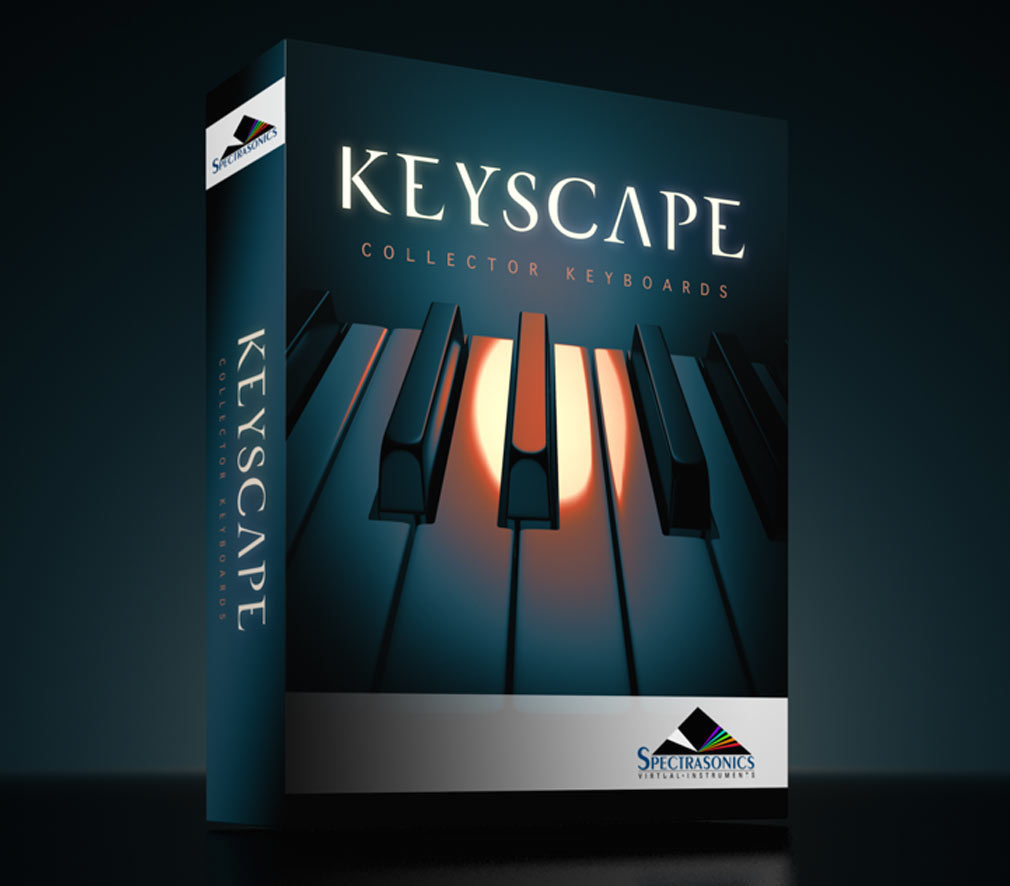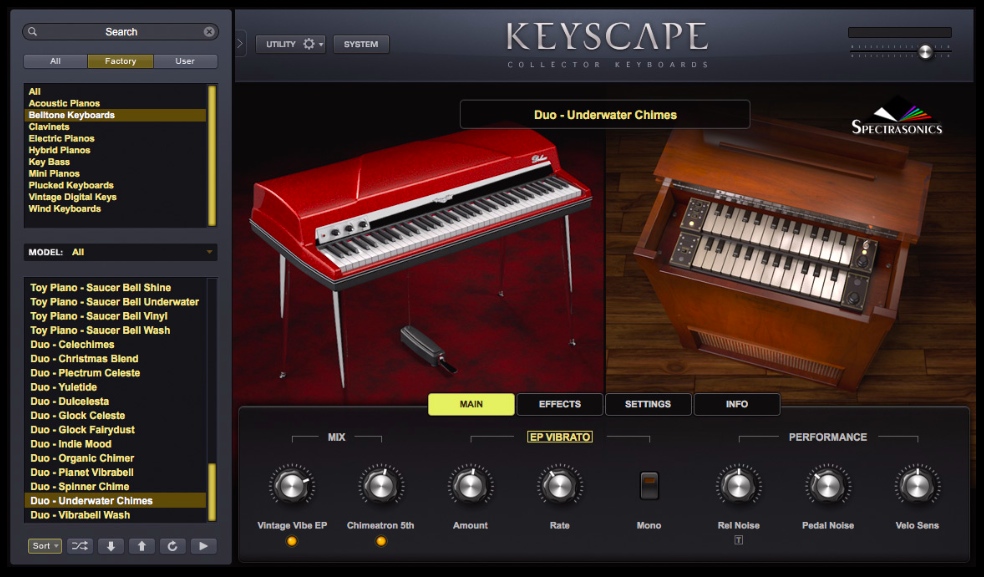New Software Review: Keyscape Collector Keyboards by Spectrasonics

Keyscape offers a large, deep library of three dozen keyboards, from the classic to the quirky, to help round out your palette of sounds.
With its new Keyscape instrument, Spectrasonics has endeavored to build a truly massive collection of some of the most sought-after “collector keyboards” in history.
Featuring a library loaded with over 500 original sounds, 36 instrument models and hybrid “Duo” patches, keyboard enthusiasts would be hard-pressed to find a more expansive collection of both classic and unusual keyboard instruments.
In addition to its inspiring and expressive palette of tones, at a $379 street price, this massive collection carries a slightly higher price tag than some. Today, we take a closer look to see whether Keyscape is a must-have for your studio.
Features and Use
If you’ve downloaded a sample library instrument before, like Native Instruments’ Kontakt or IK Multimedia’s SampleTank, then the installation of Keyscape shouldn’t be too tricky. I always try and save my samples to a dedicated sample drive (in this case, my 4TB Lacie Rugged Raid) and download the application directly to my computer’s main drive.
It’s useful to note that there is a “Lite” installation option for Keyscape which gives you 30GB of instruments, as opposed to the 77GB available in the full install. The Lite install, however, still offers a wide variety of sounds, featuring the Hohner Clavinet C, LA Custom C7, Rhodes Classic Mark I, and the Wurlitzer 140B, to name a few. I would highly recommend the Lite install if you’re a keyboard player looking to use Keyscape in a live performance situation, which I’ll talk about in a moment.
Now would probably be a good time to inform you that I am not primarily a keyboard player. Having said that, I’ve played more than my fair share of both vintage and modern keyboards, and I do spend much of my time on YouTube and eBay searching for vintage Rhodes, Wurlys and the like.

Spectrasonics have gone to great lengths in sampling an extremely diverse and specially-curated collection of vintage pianos and keyboards for Keyscape.
I found the Rhodes and Wurlitzer patches here to all be incredibly authentic sounding and sonically inspiring, with some very unique character and flourishes. I was happy to finally find a software Clavinet that doesn’t sound like obnoxious duck quacking. There’s some really clever programming going on in these patches, and I was amazed by the level of Spectrasonics’ attention to detail in tiny sonic features, such as the sustain pedal triggering the quiet sound of a player putting their foot on the pedal of an actual piano.
The “Duo” patches they created turned out to be a phenomenal resource of inspiration and, if you’re an Omnisphere 2 user, you can easily create your own by layering any two models together. Discovering new instruments and textures this way is a common occurrence while using Keyscape.
Spectrasonics’ take on the Rhodes Piano Bass (an instrument I didn’t even know existed) was a fantastic addition that had me pleasantly surprised. The low end on this particular patch is astounding, and added a much needed color for my production toolkit. The sounds of the Weltmeister Basset 1 and 2 are jaw-dropping, and the LA Custom C7 Grand Piano is now my go-to instrument for writing sessions—as well as a great substitute for a real grand piano when I don’t have the time or budget to record one.
I wish I could go into detail about every instrument in Keyscape, but in the interest of time, I can say that there wan’t a single one that left me disappointed. It’s not just the rich sample library here that gives Keyscape its value though. There are plenty of functional details that make it great to work with.
For instance, one of the best features of Keyscape for me was its velocity curves, which you may be familiar with already if you own Spectrasonics’ Omnisphere 2 or Trilian. According to Spectrasonics, “The highly dynamic and expressive instruments in Keyscape have been recorded with incredible depth, so it is important to set Keyscape to respond properly to your keyboard controller. We included a variety of velocity curves optimized specifically for the most popular keyboard and controllers.”
I tried Keyscape with a few different MIDI controllers—a Roland AX-09, AKAI MPK49, AKAI MPK88, and even my guitar using Jam Origin MIDI Guitar—and setting the velocity curves appropriately for each controller made the playing experience much more enjoyable and effective. On a fully-weighted piano controller, the results with headphones are shockingly realistic; I was almost convinced that I was in a room in front of a real piano when playing on the AKAI MPK 88 with my eyes closed.

The ability to create customized “Duo” patches is just one of the many ways Keyscape is unique in both its sound and its functionality.
As an Ableton Live enthusiast, I tried putting some Keyscape patches into a generic keyboard rig I made in Ableton for live performances. Running the full version off my sample drive worked well, and I had no dropouts or issues where the sample couldn’t load in time to keep up with my playing—an issue I’ve run into occasionally with some of my favorite Kontakt pianos.
Another highlight of Keyscape is that if you own Omnisphere 2, you can use Keyscape as a library within the software. In this case, instead of being restricted to the Duo layer limitation of Keyscape, you can layer up to eight sounds in “Stack Mode” and come up with some massive patches.
If you own both titles from Spectrasonics, you can go to their website and download the Keyscape Creative Library, a free collection of 1,268 patches that showcase the potential of both titles working in tandem. The Spectrasonics sound design department really killed it with this collection, and if I feel like I’m in a creative rut, this would be a go-to library to consult for inspirado.
To Be Critical
The one area where Keyscape was a tad troublesome was CPU usage. Honestly, it performed much better than I thought it would compared to some of my favorite Kontakt pianos and electric keyboards, but it’s still worth noting that it can be quite taxing on your processing.
Though the install size of 77GB is quite large, it pales in comparison to other virtual instruments on the market. For example, one of my favorite Kontakt pianos by Spitfire Audio, the Hans Zimmer Piano, is a massive 211GB—and that’s just for one piano!
Considering the sheer number of instruments and patches you get with Keyscape, the 77GB download size isn’t that bad, and if you don’t have the space, you can always opt for the 30GB version. There’s even a thinning button which uses fewer velocity layers and round robins per note, making Keyscape run even more efficiently.
Another minor critique is that, although there is a wide variety of exceptional electric pianos, toy pianos, upright pianos, and clavinets, and the like, the LA Custom C7 is the only available grand piano. Having said that, it is a very versatile instrument—especially given the 21 distinct presets it comes stock with—but I would have liked to have seen a Steinway or Bösendorfer.
Summing it Up
If I were primarily a keyboard player, Keyscape would be a must-have for every writing and recording session in the same way that a great amp sim is a must-have for me as a guitar player.
If you like the sound of keyed instruments or you’re looking for a creative toolbox of amazing sounding patches that will also integrate with Omnisphere 2, look no further.
At a price point of $379 street, Keyscape doesn’t come cheap, but considering what’s under the hood, the expense would be well-justified for those in the market for a vast selection of pro-level keyboard tones.
Please note: When you buy products through links on this page, we may earn an affiliate commission.






